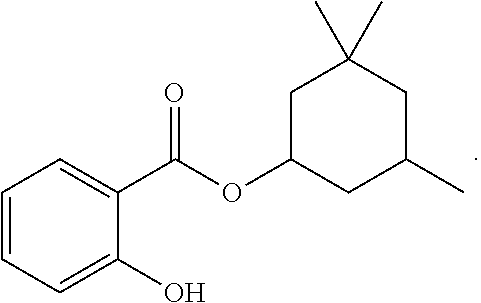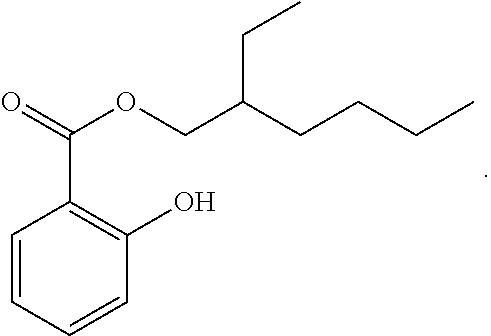Sunscreen formulations
- Summary
- Abstract
- Description
- Claims
- Application Information
AI Technical Summary
Benefits of technology
Problems solved by technology
Method used
Image
Examples
example 1
(Testing Vehicles)
[0084]Tables 1 and 2 describe generic skin testing formulations in which the sunscreen agents, solubilizers, and stabilizers can be incorporated into to determine the efficacy and stability of the composition to protect skin from UVA and UVB protection.
TABLE 1*% ConcentrationIngredient(by weight)Phase AWaterq.s.Xanthum gum0.1M-paraben0.15P-paraben0.1Citric acid0.1Phase BCetyl alcohol4.0Glyceryl stearate +4.0PEG 100Octyl palmitate4.0Dimethicone1.0Tocopheryl acetate0.2Phase C**Activesas neededTOTAL100*Procedure for making composition: Sprinkle Xanthum gum in water and mix for 10 min. Subsequently, add all ingredients in phase A and heat to 70-75° C. Add all items in phase B to separate beaker and heat to 70-75° C. Mix phases A and B at 70-75° C. Continue mixing and allow composition to cool to 30° C. Subsequently, add phase C ingredient while mixing.**The actives to test include a combination of 3,3,5-trimethylcyclohexyl 2-hydroxybenzoate, 2-ethylhexyl 2-hydroxybenzo...
example 2
(Sample Formulations)
[0087]The compositions in Tables 3 and 4 are sample formulations that were found to be particularly effective in providing broadband protection of UVA and UVB radiation. For instance, the Table 3 formulation was determined to have an SPF value of around 35 and also a PVA value of at least 8, thereby categorizing it as a PA+++ sunscreen. Indeed, this formulation falls into the 3:1 ratio protection of UVB to UVA. As for the Table 4 formulation, it was found to have an SPF of around 50 and also a PVA value of at least 8, thereby categorizing it as a PA+++ sunscreen. Further testing confirmed that the Tables 3-4 formulations are lotions that have long-term stability (i.e., the solubility of the sunscreen agents within the composition can be stored at room temperature / about 20-25° C. for 1 year) as determined by a standard heat stability test.
TABLE 3*% ConcentrationIngredient(by weight)Water51.53,3,5-trimethylcyclohexyl 2-hydroxybenzoate102-ethylhexyl 2-hydroxybenzoa...
example 3
(Additional Assays)
[0088]Compositions of the present invention (e.g., those disclosed in Tables 1-4) can be assayed to determine the ability of such compositions to treat other skin-related conditions.
[0089]Erythema Assay: An assay to measure the reduction of skin redness can be evaluated using a Minolta Chromometer. Skin erythema may be induced by applying a 0.2% solution of sodium dodecyl sulfate on the forearm of a subject. The area is protected by an occlusive patch for 24 hrs. After 24 hrs, the patch is removed and the irritation-induced redness can be assessed using the a* values of the Minolta Chroma Meter. The a* value measures changes in skin color in the red region. Immediately after reading, the area is treated with a composition of the present invention. Repeat measurements are taken at regular intervals to determine the formula's ability to reduce redness and irritation.
[0090]Skin Moisture / Hydration Assay: Skin moisture / hydration benefits can be measured by using impeda...
PUM
| Property | Measurement | Unit |
|---|---|---|
| Fraction | aaaaa | aaaaa |
| Fraction | aaaaa | aaaaa |
| Fraction | aaaaa | aaaaa |
Abstract
Description
Claims
Application Information
 Login to View More
Login to View More - R&D
- Intellectual Property
- Life Sciences
- Materials
- Tech Scout
- Unparalleled Data Quality
- Higher Quality Content
- 60% Fewer Hallucinations
Browse by: Latest US Patents, China's latest patents, Technical Efficacy Thesaurus, Application Domain, Technology Topic, Popular Technical Reports.
© 2025 PatSnap. All rights reserved.Legal|Privacy policy|Modern Slavery Act Transparency Statement|Sitemap|About US| Contact US: help@patsnap.com



